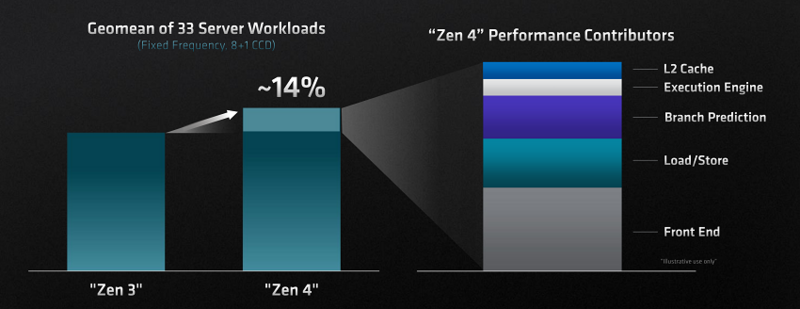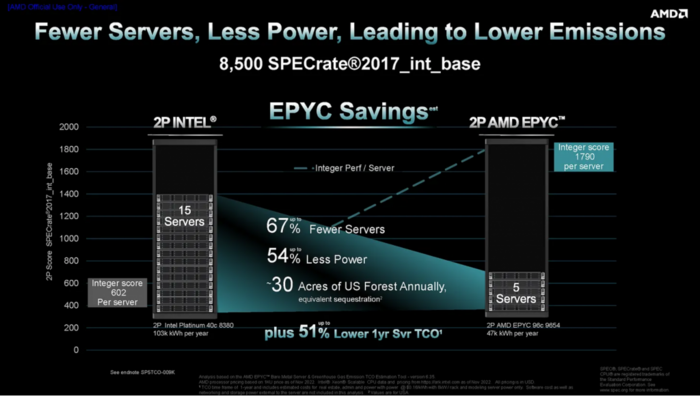AMD EPYC 9004 Genoa
EPYC Genoa
In brief : At OCP Summit 2022, AMD launching next-generation AMD EPYC 9004 4th-gen CPU, code name Genoa on November 10, 2022. AMD Genor supports up to 96 cores with 192 threads with 5nm manufacturing process. 12-channel DDR5 memory, Compute Express Link 1.1 standards as well as more PCIe Gen5 capabilities. HPCMATE with local and global partners are preparing HPC optimized AMD based server in Q2 2023.
Genoa
Code-named AMD Genoa, the new line of CPUs supports 12 channels of DDR5-4800 (up to 6TB memory capacity per socket), 128 lanes of PCIe Gen5, AMD Infinity Fabric/Guard technology, and up to 96 cores. This makes them ideal for critical workloads across cloud, enterprise, and high-performance computing.
With its massive 96-core-count in a single processor, the new AMD Genoa processors will allow organizations to reduce their physical footprint by deploying fewer servers while leveraging more powerful servers. HPE and Dell have announced their servers, each offering four systems, two 1 CPU chassis, and two 2 CPU chassis
Key features
Socket SP5
To support Zen 4 architecture based EPYC 9004 Genoa, AMD introduced SP5 (LGA 6096) socket with 2002 more contact pins than the SP3 socket to provide greater power delivery and signal integrity. SP5 can provide a peak power of up to 700W.
Memory
Genoa has key enhancements in memory cost, which is 50% of a server’s BOM. The support for 72-bit and 80-bit DIMMs is noteworthy. Most servers will use 80-bit ECC, but some hyperscalers want to cut down to 72-bit. The advantage here is that there is 1 less DRAM die for parity checks. The other important feature is dual rank versus single rank memory. With Milan and most Intel platforms, dual-rank memory is crucial to maximizing performance. There’s a 25% performance delta on Milan, for example. With Genoa, this is brought down to 4.5%. This is another considerable cost improvement because cheaper single-rank memory can be used. Genoa has higher memory latency than Milan, 118ns on Genoa versus 105ns on Milan. AMD’s argument against this is that only 3ns of this is from the massively larger IO die, 73ns on Genoa versus 70ns on Milan. Most of the memory latency impact comes from the DDR5 memory device itself. 35ns on DDR5 versus 25ns on DDR4.
The 4th Gen AMD EPYC processors are the first AMD x86 server processors to support DDR5 memory. The memory runs at speeds of up to 4,800 MT/s, which is 50 percent faster than the 3,200 MT/s that the previous 3rd Gen AMD EPYC processors supported.[1]
Power management
Power management is enhanced. Genoa has 2 basic modes for power management, performance determinism or power determinism. Performance determinism is for firms that want consistent performance. It consumes less power when allowed to, and performance is kept stable. Most customers will choose this option because stability is vital. Power determinism is for keeping power consumption stable and ramping performance up and down. Given factors such as the silicon lottery, thermal budget, and workloads, the chip will ramp up and down clock speeds. In addition to the power management modes, there is a configurable TDP for Genoa chips. The peak boost behavior will vary depending on which option is chosen.[2]
CXL 2.0 for Type 3
AMD generally supports CXL 1.1 but supports CXL 2.0 for Type 3 memory devices, One noteworthy item is that the 64 lanes of CXL can be bifurcated into 16 4x devices.
Type 3 is what the ecosystem wanted, Genoa was delayed 2 quarters to add this feature. Intel Sapphire Rapids is not capable of CXL lane bifurcation. If one connects a 4x or 8x CXL device, that will consume all 16 lanes.
Hypervisors cannot change the memory assignment under the guest, which is huge for users using CXL-attached memory in the cloud.[3]
In summary, The pillars of performance for AMD are per-socket performance leadership, per-core performance leadership, leadership across all workloads and market segments, and leadership in TCO and sustainability
EPYC Genoa series[4]
| MODEL | # OF CPU CORES | # OF THREADS | MAX. BOOST CLOCK | ALL CORE BOOST SPEED | BASE CLOCK | L3 CACHE | DEFAULT TDP |
|---|---|---|---|---|---|---|---|
| AMD EPYC™ 9654P | 96 | 192 | Up to 3.7GHz | 3.55GHz | 2.4GHz | 384MB | 360W |
| AMD EPYC™ 9654 | 96 | 192 | Up to 3.7GHz | 3.55GHz | 2.4GHz | 384MB | 360W |
| AMD EPYC™ 9634 | 84 | 168 | Up to 3.7GHz | 3.1GHz | 2.25GHz | 384MB | 290W |
| AMD EPYC™ 9554P | 64 | 128 | Up to 3.75GHz | 3.75GHz | 3.1GHz | 256MB | 360W |
| AMD EPYC™ 9554 | 64 | 128 | Up to 3.75GHz | 3.75GHz | 3.1GHz | 256MB | 360W |
| AMD EPYC™ 9534 | 64 | 128 | Up to 3.7GHz | 3.55GHz | 2.45GHz | 256MB | 280W |
| AMD EPYC™ 9474F | 48 | 96 | Up to 4.1GHz | 3.95GHz | 3.6GHz | 256MB | 360W |
| AMD EPYC™ 9454P | 48 | 96 | Up to 3.8GHz | 3.65GHz | 2.75GHz | 256MB | 290W |
| AMD EPYC™ 9454 | 48 | 96 | Up to 3.8GHz | 3.65GHz | 2.75GHz | 256MB | 290W |
| AMD EPYC™ 9374F | 32 | 64 | Up to 4.3GHz | 4.1GHz | 3.85GHz | 256MB | 320W |
| AMD EPYC™ 9354P | 32 | 64 | Up to 3.8GHz | 3.75GHz | 3.25GHz | 256MB | 280W |
| AMD EPYC™ 9354 | 32 | 64 | Up to 3.8GHz | 3.75GHz | 3.25GHz | 256MB | 280W |
| AMD EPYC™ 9334 | 32 | 64 | Up to 3.9GHz | 3.85GHz | 2.7GHz | 128MB | 210W |
| AMD EPYC™ 9274F | 24 | 48 | Up to 4.3GHz | 4.1GHz | 4.05GHz | 256MB | 320W |
| AMD EPYC™ 9254 | 24 | 48 | Up to 4.15GHz | 3.9GHz | 2.9GHz | 128MB | 200W |
| AMD EPYC™ 9224 | 24 | 48 | Up to 3.7GHz | 3.65GHz | 2.5GHz | 64MB | 200W |
| AMD EPYC™ 9174F | 16 | 32 | Up to 4.4GHz | 4.15GHz | 4.1GHz | 256MB | 320W |
| AMD EPYC™ 9124 | 16 | 32 | Up to 3.7GHz | 3.6GHz | 3.0GHz | 64MB | 200W |
The big question then is obvious, is AMD Genoa worth the investment? these new CPU technologies have a lot to offer in terms of compute power, security, and efficiency
The big thing to note is that when software per core licensing costs come into play, this lead extends even further in TCO. This is best shown in the enterprise benchmark, which runs VMMark. VMMark runs 19 representative VM per tile and then sees how many tiles can be run as well as the speed. Genoa is faster and can handle more VMs.
Reference
- ↑ https://infohub.delltechnologies.com/p/ddr5-memory-bandwidth-for-next-generation-poweredge-servers-featuring-4th-gen-amd-epyc-processors/
- ↑ https://www.semianalysis.com/p/amd-genoa-detailed-architecture-makes
- ↑ https://www.semianalysis.com/p/cxl-deep-dive-future-of-composable
- ↑ https://www.amd.com/en/products/processors/server/epyc/4th-generation-9004-and-8004-series.html

